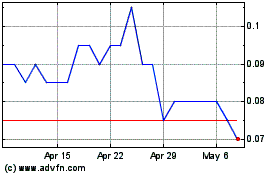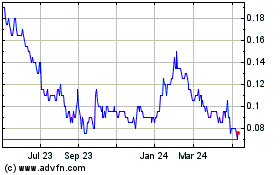Increasing Lithium-Ion Battery Demand Manganese Industry Expert Report
March 08 2022 - 4:44PM

Increasing Lithium-Ion Battery Demand: Manganese Industry
Expert Martin Kepman, CEO of Manganese X Energy
Weighs In on Ford Projects $45 Billion Profit from New EV Transit
Service.
Tesla is no longer the only player in the electric vehicle
sector, with most big-name automobile manufacturers across the
world producing electric and hybrid models to keep up with market
demand.
Ford Motor Company has recently announced its first electric
delivery van, which is set to roll out this month. The medium-duty
business van is designed for and marketed towards commercial
applications. In addition to selling the vehicles themselves, Ford
will be launching software and services — collectively named Ford
Pro Intelligence — to help companies manage their delivery fleets.
These services are set to include charging depots (to help
customers minimize energy consumption while maximizing vehicle run
time), cloud-based routing (to increase efficiency and decrease
drive time), over-the-air updates for new features, and tailored
alerts for maintenance and repairs.
In total, Ford projects a profit of at least $45 billion from
their electric transit vehicle program.
The company will be producing and selling 150,000 electric vans
(dubbed the “E-Transit”) each year as of 2023. (Fewer vehicles will
be manufactured this year.) The E-transit will be available in
three lengths and three roof heights, as well as cutaway versions
(which have a cab but no body).
Overall, the demand for medium-duty transit vehicles in the
United States is approximately 330,000 vehicles per year. Ford’s
gasoline-powered Transit vans already account for almost half of
this market. Though the point-of-sale price for the E-Transit is
around $10F,000 more than the gasoline-powered
Transit, businesses should be able to quickly make this direct cost
back through energy and efficiency savings.
Three of the thirteen gigafactories set to open in the U.S. in
the next five years will belong to Ford. These gigafactories will
focus on battery production for electric vehicles. Most of Ford’s
existing electric vehicles use lithium-ion batteries, which are the
most sustainable, energy efficient batteries that modern technology
currently has to offer.
Lithium-ion batteries are a staple of everyday life, powering
everything from electric vehicles to electric toothbrushes and
smartphones and laptops. As the demand for lithium-ion batteries
rises even further due to new products and programs in the electric
vehicle sector, so does the demand for one of the key components of
these batteries: manganese.
Manganese is an essential component of the lithium-ion battery,
but it is also used in the other most common type of battery
produced globally, the nickel-manganese-cobalt (NMC) battery.
“There are plans to re-engineer the chemistry of the current NMC
battery by eliminating cobalt and increasing the proportion of
manganese in future lithium-ion nickel manganese EV batteries. Some
of the reasons that make manganese potentially the mineral of the
decade is it doesn’t have the ethical sourcing issues of mining
cobalt in the Congo, where the majority of cobalt is produced.
Economically, cobalt is 10-47 times more expensive than manganese
to acquire, based on the commodity markets of fluctuating prices.
Safety, manganese is renowned for its stability in nature and has
the characteristics of increasing energy density, which ultimately
increases capacity and improves driving range. Also, manganese
decreases the combustibility of EV batteries, which is problematic
with cobalt infused lithium-ion batteries. Our strategically
located manganese property in Canada will provide EV battery
manufacturers access to a domestic supply with less reliance on
China imports, “ Martin Kepman CEO of Manganese X Energy Corp.
Locating and mining manganese deposits will be an important goal
for the electric vehicle industry. Manganese can be found in rich
deposits in North America, such as in the Battery Hill manganese
site in Woodstock, New Brunswick, Canada.
About Manganese X Energy
Manganese X Energy Corp. (TSXV: MN) (FSE: 9SC2) (OTC:QB:MNXXF)
(FRANKFURT:
9SC2) with its head office in Montreal QC, owns 100% of the
Battery Hill property project (1,228 hectares) located in New
Brunswick Canada. Battery Hill is strategically situated 12
kilometers from the US (Maine) border, near existing
infrastructures (power, railways, and roads). It encompasses all or
part of five manganese-iron zones, including Iron Ore Hill, Moody
Hill, Sharpe Farm, Maple Hill and Wakefield. According to Brian
Way’s (2012) master’s thesis on the Woodstock manganese
occurrences, that includes Battery Hill, the area “hosts a series
of banded iron formations that collectively constitute one of the
largest manganese resources in North America, approximately
194,000,000 tons.
Media contact:
Rene Perras Digital PR Consultant
for Manganese X Energy Corp
514-816-4446
When sharing on social media please help us by using these
hashtags:
#ManganeseXEnergyisElectricGold
#ManganeseXMinerforElectricGold
#ManganeseisElectricGold #ManganeseXisElectricGold
New Brunswick, Canada
https://www.manganesexenergycorp.com
###
Cautionary Note Regarding Forward-Looking Statements: Neither
TSX Venture Exchange nor its Regulation Services Provider (as that
term is defined in the policies of the TSX Venture Exchange)
accepts responsibility for the adequacy or accuracy of this
release. This news release contains “forward-looking information”
which may include statements with respect to the future exploration
performance of Manganese X Energy Corp (the “Company”). This
forward-looking information involves known and unknown risks,
uncertainties and other factors which may cause the actual results,
performance, or achievements of the Company to be materially
different from any future results, performance or achievements of
the Company, expressed or implied by such forward-looking
statements. These risks, as well as others, are disclosed within
the Company’s filing on SEDAR, which investors are encouraged to
review prior to any transaction involving the securities of the
Company. Forward-looking information contained herein is provided
as of the date of this publication and the Company disclaims any
obligation, other than as required by law, to update any
forward-looking information for any reason. There can be no
assurance that forward-looking information will prove to be
accurate, and the reader is cautioned not to place undue reliance
on such forward-looking information. We seek safe harbor.
- Increasing Lithium-Ion Battery Demand Manganese Industry
Manganese X Energy (TSXV:MN)
Historical Stock Chart
From Jan 2025 to Feb 2025

Manganese X Energy (TSXV:MN)
Historical Stock Chart
From Feb 2024 to Feb 2025
